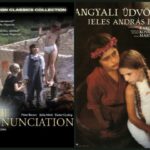In the collective imagination, William Golding’s “Lord of the Flies” is a disturbing portrait of human nature and the descent of innocence into darkness. The work’s rawness, deep symbolism, and its harsh indictment of the myth of childhood innocence make it a cornerstone of 20th-century literature.
Golding presents a group of boys marooned on a deserted island, an ostensibly idyllic setting that quickly morphs into a theater of brutal self-destruction. The group’s gradual moral decay, under the growing influence of a sinister entity called “The Lord of the Flies,” conjures the tension between civilization and chaos, order and savagery. This tension is underscored by the title itself, an echo of Beelzebub, a biblical figure often associated with the devil and corruption.

The stunning 1963 film, directed by Peter Brook, faithfully follows the novel, albeit with some stylistic and interpretive divergences. The black-and-white cinematography accentuates the dichotomy between light and shadow, good and evil, through sharp visual storytelling. The expressions of the young actors are gut-wrenching, making the characters’ anguish and psychological torment vividly felt. However, while the novel allows for deep internal reflection, the film tends to lay bare the depravity in a more explicit manner, making the visual experience at times unsettling.
The incorporation of the fly in painting introduces an even more complex dimension. Traditionally in art, the fly represents the transience of life, mortality, and decay. This can be seen, for example, in 17th-century still lifes, where tiny flies settle on rotting fruit or wilted flowers, symbolizing the fleeting splendor of life. This interpretation can also be applied to Golding’s novel: the island, initially seen as a paradise, gradually decomposes under the influence of the flies, that is, human baseness.

In conclusion, “Lord of the Flies” is more than just a simple adventure tale or a sociological analysis of childhood. It’s a profound examination of the human condition, exploring how vulnerabilities and weaknesses can surface even in the most innocent of circumstances. Both in the novel and the film, and even more so when considering the rich symbolic tapestry of the fly in painting, there emerges a dark meditation on the transitory nature of life and the eternal struggle between civilization and barbarity.












